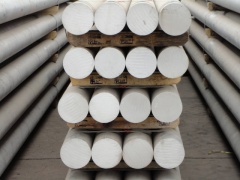Aluminium Castings
| Infobox on Aluminium Castings | |
|---|---|
| Example of Aluminium Castings |  |
| Facts | |
| Origin | - |
| Stowage factor (in m3/t) | 0,5/0,65 m3/t (ingots) |
| Humidity / moisture | - |
| Ventilation | - |
| Risk factors | - |
Aluminium Castings
Description
Semi-finished casting products are intermediate castings produced in a foundry that need further processing before being a finished good. There are four types: ingots, billets, blooms, and slabs.
Ingots
Ingots are large rough castings designed for storage and transportation. The shape usually resembles a rectangle or square with generous fillets. They are tapered, usually with the big-end-down.
Billets
A billet is a length of metal that has a round or square cross-section, with an area less than 36 sq in (230 cm2). Billets are created directly via continuous casting or extrusion or indirectly via rolling an ingot. Billets are further processed via profile rolling and drawing. Final products include bar stock and wire.
Centrifugal casting is also used to produce short circular tubes as billets, usually to achieve a precise metallurgical structure. They are commonly used as cylinder sleeves where the inner and outer diameters are ground and machined to length. Because their size is not modified significantly, they are not always classified as semi-finished casting products.
Blooms
Blooms are similar to billets except the cross-sectional area is greater than 36 sq in (230 cm2). Blooms are usually further processed via rotary piercing, structural shape rolling and profile rolling. Common final products include structural shapes, rails, rods, and seamless pipes.
Slabs
A slab is a length of metal that is rectangular in cross-section. It is created directly from continuous casting or indirectly by rolling an ingot. Slabs are usually further processed via flat rolling, skelping, and pipe rolling. Common final products include sheet metal, plates, strip metal, pipes, and tubes.
For further particulars see Aluminium
Shipment/storage
These semi-finished products are generally transported by sea unwrapped and unprotected against corrosion/oxidation. They are usually stored in the open and exposed to the elements.
Each item is heavy, and in a ship’s hold providing the top tier is chocked off in the gaps between individual pieces where necessary, should be adequately secured against movement during the voyage.
Owing to the weight involved, such goods should be stowed in the bottom of the ship if possible, and the dunnage beneath the lower tiers should be placed directly above the transverse floors to prevent spot overloading of the tanktop plating.











